The terahertz technologies market is estimated to be valued at US$ 1.45 Bn in 2025 and is expected to reach US$ 5.34 Bn by 2032, growing at a compound annual growth rate (CAGR) of 20.5% from 2025 to 2032. This growth can be attributed to increasing applications of terahertz technologies across the healthcare and life sciences, telecommunications, security and defense, and semiconductor industry verticals.
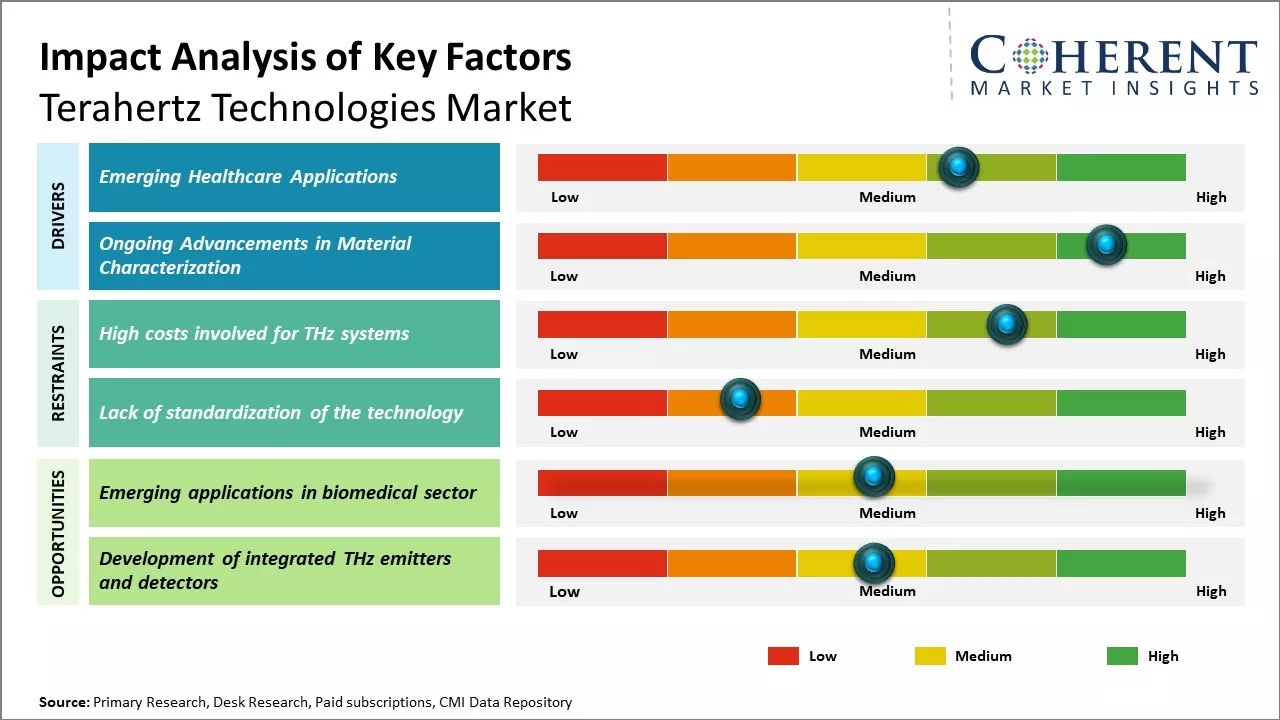
Discover market dynamics shaping the industry: Request sample copy
The terahertz technologies market is expected to witness significant growth due to rising demand for terahertz scanners at airports for security screening applications. Furthermore, the rising emphasis on innovating terahertz sources, detectors, and imaging methods for identifying chemical and biological threats will drive the demand for terahertz technologies in defense and security.
Emerging Healthcare Applications
The terahertz technology market holds immense potential in the field of healthcare and biomedical sciences. Terahertz rays occupy a region of the electromagnetic spectrum between microwaves and infrared light. This allows terahertz waves to penetrate various non-conducting materials like plastics, fabrics, wood and biological tissues. As the technology progresses further, new terahertz-based healthcare devices and systems are emerging which can drive significant growth in the terahertz technologies market.
Terahertz imaging is one such application which is gaining widespread attention from both healthcare providers and researchers. Terahertz imaging systems utilize the penetration ability of terahertz waves to detect anomalies underneath the skin or other tissues. This non-invasive and non-ionizing technique is being extensively researched for tumor detection, burn assessment, wound inspection and dental imaging. As the technology matures, terahertz-based medical imaging devices have the potential to replace conventional X-ray systems for many applications. This will ensure safer diagnosis and monitoring of various conditions without exposing patients to harmful ionizing radiations. Various research studies are also exploring the feasibility of terahertz imaging for skin cancer detection which can potentially achieve very high sensitivity and selectivity. If successful, this can prove highly beneficial in early diagnosis and prevention of one of the most common forms of cancer.
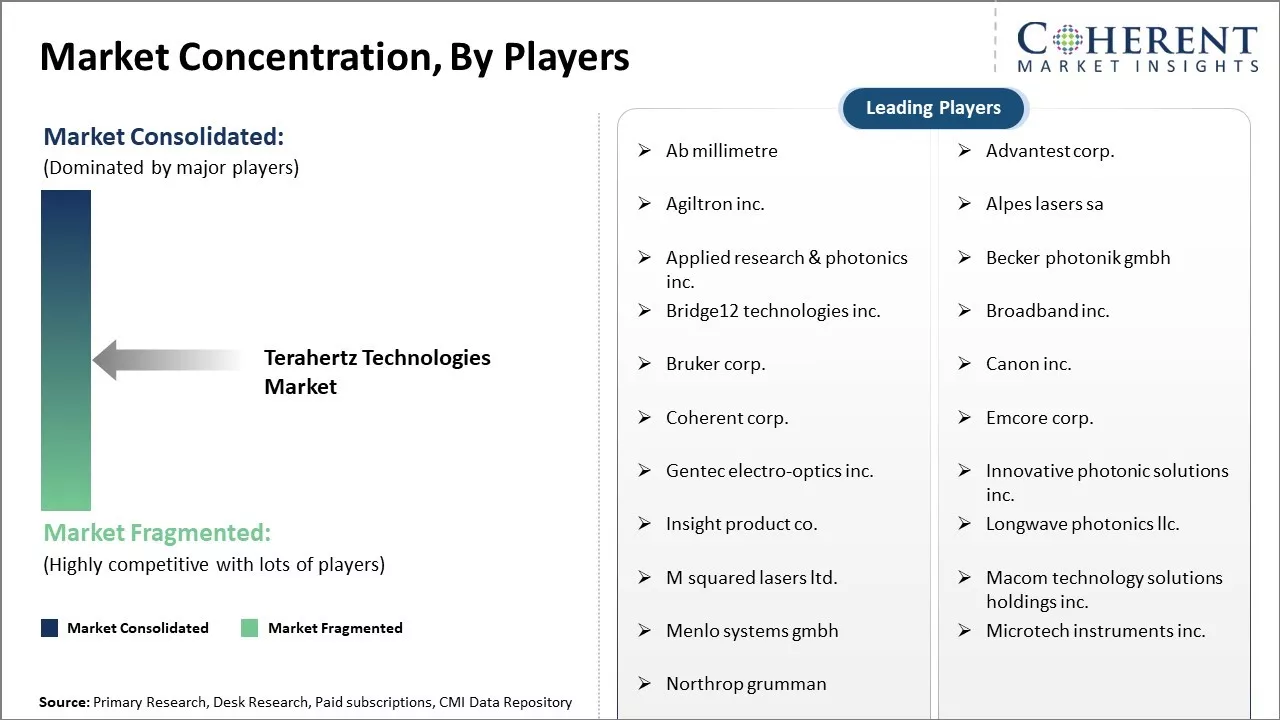
Get actionable strategies to beat competition: Request sample copy
Ongoing Advancements in Material CharacterizationThe field of terahertz technology is continuously evolving with advancements happening both in sources and detection techniques. Researchers across the world are working on developing more efficient terahertz sources, detectors, and imaging systems which can expand the scope of terahertz applications. One key area which is benefiting from ongoing innovations is material characterization and inspection. Terahertz radiation, due to its low photon energy, is non-destructive for samples and can provide valuable information about the molecular structure and composition of materials. It can easily identify molecular fingerprints and analyze layered structures. These capabilities are driving interest from sectors like pharmaceuticals, semiconductors, homeland security, and cultural heritage preservation.
Various industries are exploring terahertz spectroscopy and imaging solutions for applications like tablet coating thickness measurement, contaminant detection, gemstone evaluation, and artwork analysis. With continuous innovations, systems are becoming more powerful, compact, and cost-effective. This is increasing the feasibility of commercial deployment of terahertz devices for both research and industrial inspection needs.
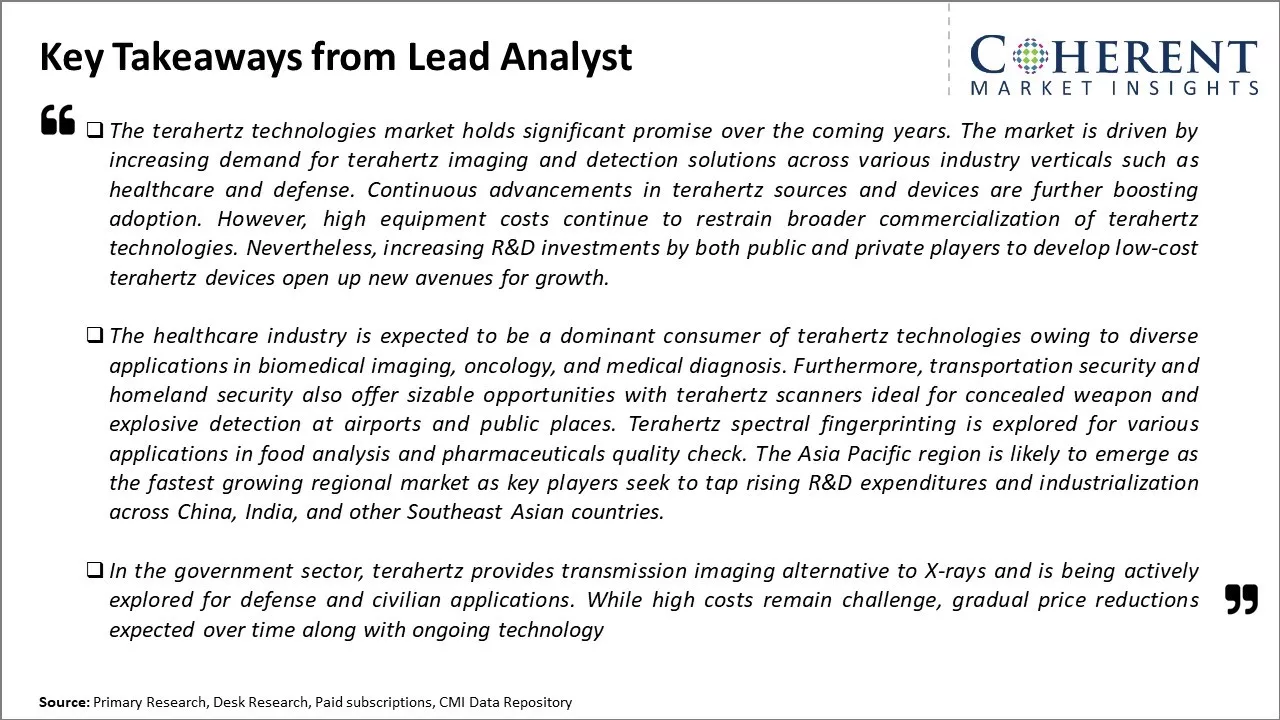
To learn more about this report, Request sample copy
Market Challenges: High costs involved for THz systemsDeveloping strong and cost-effective terahertz sources that can generate tunable, continuous wave and high power radiation across the terahertz frequencies remains difficult. Additionally, improving the resolution and sensitivity of terahertz detectors while bringing down costs is an ongoing challenge. Integrating terahertz components such as sources and detectors efficiently into real-time imaging and spectroscopy platforms suitable for practical applications also presents difficulties.
Market Opportunities: Emerging applications in biomedical sector
Terahertz spectroscopy and imaging hold promise for newly emerging application areas such as quality control and assurance in industries like pharmaceutical and food processing. Non-destructive evaluation and materials characterization using terahertz waves offer advantages over existing technologies.
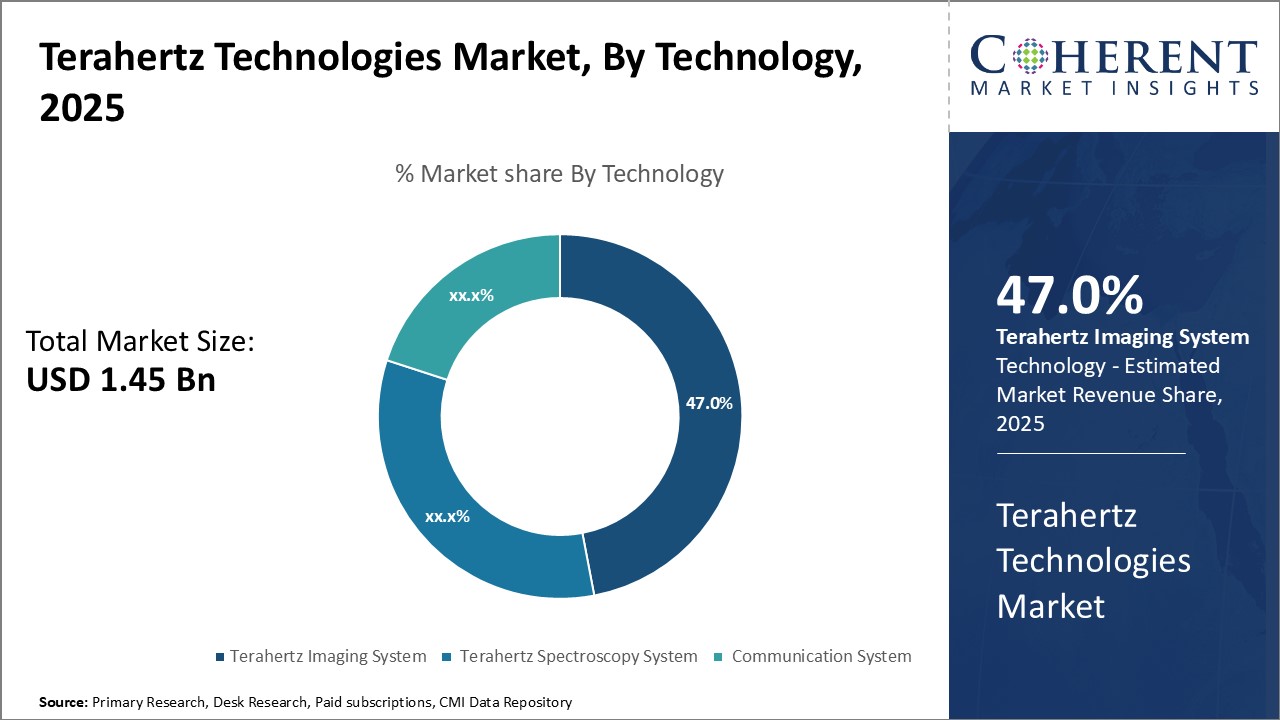
Discover high revenue pocket segments and roadmap to it: Request sample copy
Insights, By Technology- Terahertz imaging system contributes the highest share of the market owing to its widespread applicationsTerahertz imaging system has seen immense growth in adoption rates due to their non-invasive and non-destructive inspection capabilities. The segment is expected to hold 47.0% of the market share in 2025. These systems are able to detect concealed objects such as weapons, explosives, and chemicals under clothing, paper, cardboard, plastics, and various other materials. They are increasingly being used for security screening at airports, government facilities and event venues to enhance security protocols.
Terahertz imaging is also finding numerous applications in the industrial sector. It is used for quality control and defect analysis of printed circuit boards, pharmaceuticals and other manufactured goods. The ability to see underneath coatings, packaging and other layers makes it useful for detecting manufacturing and assembly defects. Terahertz scans are non-contact and do not damage samples like X-rays, making them suitable for inline quality control.
The healthcare industry has been a major adopter of terahertz imaging technology. It allows for detailed inspections of biological tissues for diagnosing conditions like cancer, burns and skin lesions. Terahertz waves are able to penetrate a few millimeters into the body without being harmful like ionizing radiation. This reduces risks for patients and enables examination of superficial tumors, teeth and burns in a comfortable, cost-effective manner.
Thanks to these diverse applications across sectors, terahertz imaging systems account for the largest revenue share of the overall terahertz technologies market. Advancements improving image quality, scan speed and integration into existing devices will continue to drive further uptake of these systems.
Insights, By End User - Telecommunications contribute the highest share owing to its role in next-gen wireless communication
Terahertz waves have the potential to revolutionize wireless communication networks as traditional microwave technology approach their capacity limits owing 31.35 market share in 2025. The terahertz spectrum between 100 GHz to 10 THz is largely unregulated and can accommodate extremely high bandwidth wireless connections ideal for meeting escalating data demands.
Telecom operators and technology giants have been investing heavily in developing terahertz devices and systems to enable secure, high-speed data transmission solutions like terahertz wireless networks, multi-gigabit wireless USB and wireless gigabit Ethernet. Terahertz frequencies combine the high bandwidth of infrared with the better atmosphere penetration of microwaves to facilitate extremely fast wireless data transfer over short distances.
Emerging terahertz-based solutions are well-suited for alleviating network congestion in wifi hotspots, connecting portable devices at high speeds as well as backhauling 5G small cells and providing fiber-like speeds without cables. This positions terahertz frequencies as the future of wireless backhaul, making telecom the largest end user segment. As wireless data usage rises exponentially worldwide, major players are expanding their terahertz communication R&D to deploy 6G ultra-broadband networks by the late 2020s.
Innovations in transceiver chips, antennas and signal modulation techniques will be the driving force behind commercialization of technologies like terahertz data links, resulting in continued strong market prospects for the telecom vertical.
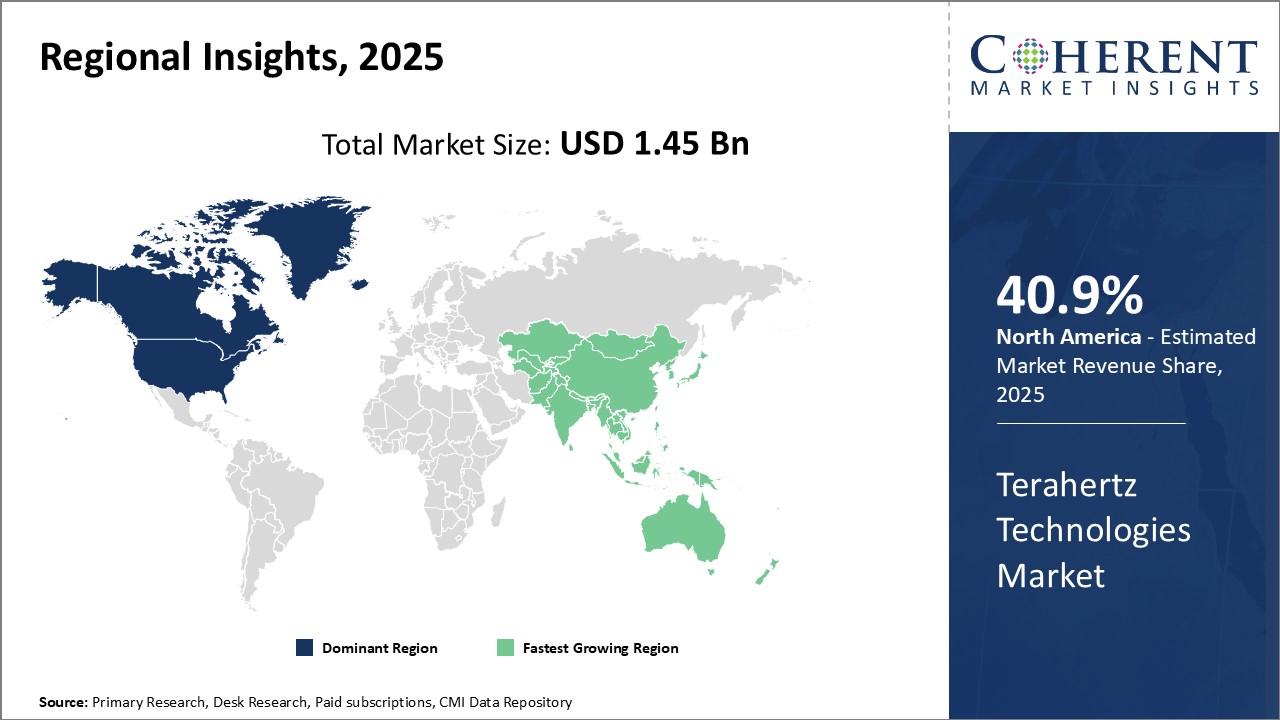
Need a Different Region or Segment? Customize now
North America has established itself as the dominant regional market. The region is expected to account for 40.9% of the market share in 2025. With strong government funding for R&D and major industry players based in the U.S. and Canada, the region accounts for the largest share of the terahertz technologies market. The presence of leading technology companies continuously investing in developing terahertz applications for commercial use has created a vibrant ecosystem for innovation. Several proof-of-concept and field tests are being run across different industry verticals such as healthcare, homeland security, manufacturing, and automotive.
The Asia Pacific region has emerged as the fastest growing regional market for terahertz technologies in recent years. Countries such as China, Japan, South Korea, and India are witnessing rising adoption driven by increasing spending on scientific research from both public and private organizations. Local production of terahertz components by Chinese, Japanese, and Korean electronics firms has made terahertz systems more affordable. This has augmented their usage in diverse pilot projects. The availability of low-cost terahertz devices is expanding the potential use cases beyond traditional industries to newer application areas as well.
The growing international trade between Asia Pacific and North American nations is also positively impacting the terahertz market. Major system integrators and technology startups from North America are actively partnering with Asian counterparts to test terahertz solutions customized for the regional requirements. Meanwhile, Asian governments are collaborating on joint R&D initiatives utilizing the complementary strengths of institutions across countries. Such cross-industry alliances and cooperative research are accelerating technology maturation and commercialization efforts.
While North America currently commands the highest revenue share, the Asia Pacific region is distinguished by its burgeoning domestic demand and globally competitive manufacturing base. An influx of venture capital investments and strategic partnerships between stakeholders across the two dominant regions will be crucial in scaling up the commercial-grade production of terahertz systems. This will pave the way for the technology's widespread deployment over the coming years.
Terahertz Technologies Market Report Coverage
| Report Coverage | Details | ||
|---|---|---|---|
| Base Year: | 2024 | Market Size in 2025: | USD 1.45 Bn |
| Historical Data for: | 2020 To 2024 | Forecast Period: | 2025 To 2032 |
| Forecast Period 2025 to 2032 CAGR: | 20.5% | 2032 Value Projection: | USD 5.34 Bn |
| Geographies covered: |
|
||
| Segments covered: |
|
||
| Companies covered: |
Ab millimetre, Advantest corp., Agiltron inc., Alpes lasers sa, Applied research & photonics inc., Becker photonik gmbh, Bridge12 technologies inc., Broadband inc., Bruker corp., Canon inc., Coherent corp., Emcore corp., Gentec electro-optics inc., Innovative photonic solutions inc., Insight product co., Longwave photonics llc., M squared lasers ltd., Macom technology solutions holdings inc., Menlo systems gmbh, Microtech instruments inc., and Northrop grumman |
||
| Growth Drivers: |
|
||
| Restraints & Challenges: |
|
||
Uncover macros and micros vetted on 75+ parameters: Get instant access to report
*Definition: The terahertz technologies market involves developing and commercializing devices and systems that operate with electromagnetic waves in the terahertz frequency range, between microwaves and infrared light. This emerging market is focused on creating applications for terahertz spectroscopy, imaging, and communication technologies. Products include terahertz spectrometers, cameras, and sources that have potential uses in areas like healthcare, security, manufacturing, and wireless data transmission.
Share
Share
About Author
Ankur Rai is a Research Consultant with over 5 years of experience in handling consulting and syndicated reports across diverse sectors. He manages consulting and market research projects centered on go-to-market strategy, opportunity analysis, competitive landscape, and market size estimation and forecasting. He also advises clients on identifying and targeting absolute opportunities to penetrate untapped markets.
Missing comfort of reading report in your local language? Find your preferred language :
Transform your Strategy with Exclusive Trending Reports :
Frequently Asked Questions
Joining thousands of companies around the world committed to making the Excellent Business Solutions.
View All Our Clients
US Reciprocal Tax Impact Analysis On Terahertz Technologies Market
Stay updated on tariff changes with expert insights and timely information